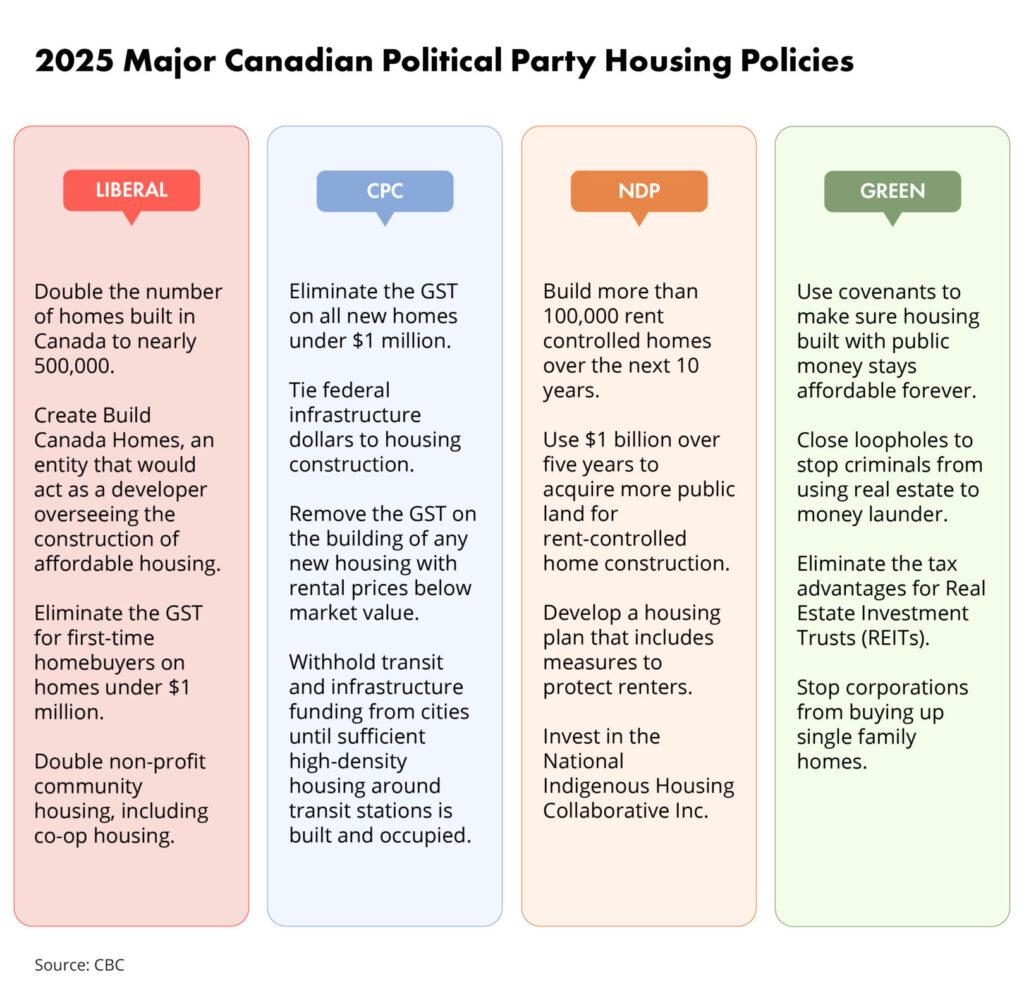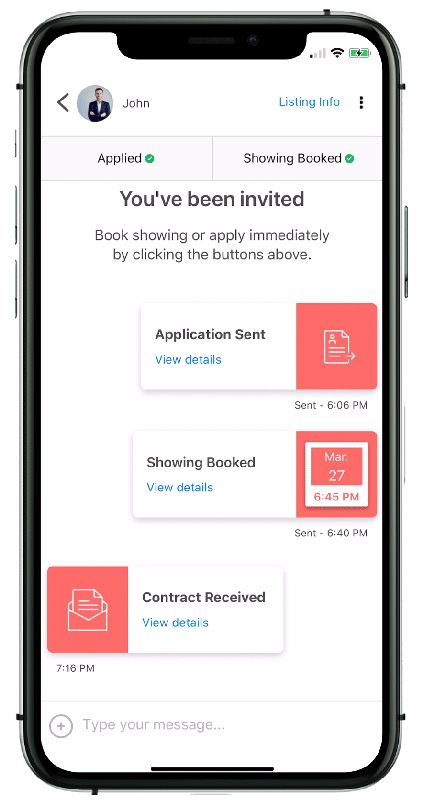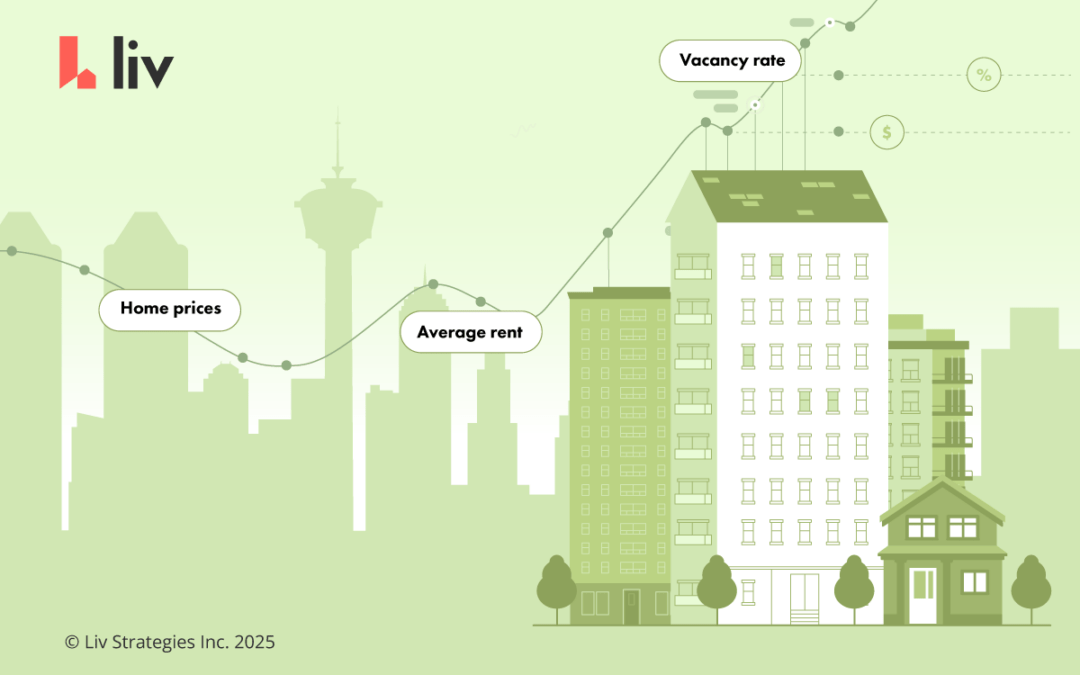With the federal election approaching, housing has become one of the most talked-about topics across the country. Whether it’s renting, buying, or building, Canadians are navigating a wide range of challenges, from rising costs and limited supply to changing mortgage rules and affordability concerns. As parties begin rolling out their platforms, housing is once again taking centre stage in national conversations.
But with so much information coming from different sources, it can be hard to keep track of what’s being proposed and how it might impact you. That’s why we’ve created this guide to break down what each major party is saying about housing, outline key policies in simple terms, and give you everything you need to stay informed this election season. We’ve also included important voting details and deadlines to make sure you’re ready when it’s time to cast your ballot.
Rent your perfect home with liv.rent
Search houses, rooms, condos and apartments for rent. Chat instantly with verified landlords. Apply to multiple listings. Save your chat history & signed documents all on one platform.
The current state of Canada’s housing market
Housing in Canada has become increasingly unaffordable over the last decade, with home prices and rental rates outpacing wage growth in nearly every major city. In Vancouver, Toronto, and even smaller urban centres, the average renter now spends more than 30% of their income on housing, a threshold that defines “core housing need” according to the Canada Mortgage and Housing Corporation (CMHC).
Interest rate rises by the Bank of Canada since 2022 have cooled demand slightly but have also made mortgage qualifications more difficult, especially for first-time home buyers, this has begun to change recently. Meanwhile, new housing construction hasn’t kept pace with population growth. In short, there are not enough homes being built, and what is available remains out of reach for many Canadians.
>> Read More: How To Negotiate Rent: 6 Steps That Save Tenants Money
What each major party is promising for Canada housing
All four major political parties have made housing a top issue in their platforms. Below is a breakdown of what each one is proposing and how it might impact renters, buyers, and the broader Canadian real estate market.
Liberal Party of Canada
The Liberal Party’s housing platform focuses on accelerating construction, improving affordability, and helping younger Canadians save for their first home. Their headline promise is to build, preserve, and revitalize 1.4 million homes over the next four years. This includes both market-rate housing and affordable rental units, with an emphasis on revitalizing aging buildings in existing communities to prevent displacement.
A cornerstone of their strategy is the $4 billion Housing Accelerator Fund, aimed at streamlining municipal approval processes and incentivizing cities to increase housing density. This fund was first introduced in the previous term and is now being expanded to target the creation of 100,000 middle-class homes by the 2024–2025 fiscal year.
The Liberal Party’s current housing policy includes eliminating the Goods and Services Tax (GST) for first-time homebuyers on homes priced at or under $1 million. This initiative aims to reduce upfront costs, thereby facilitating access to homeownership for more Canadians.
Conservative Party of Canada
The Conservative Party’s platform focuses on rapidly increasing the housing supply while also reforming mortgage policies to support long-term affordability. Their plan to build 1 million homes over three years is one of the most aggressive supply-side targets among all parties. The goal is to unlock more land for development and ease regulatory burdens that slow down the building process.
One unique component of the Conservative strategy is the integration of public transit development with housing construction. Municipalities seeking federal funding for transit infrastructure would be required to increase housing density near new transit lines. This not only supports sustainable urban growth but also aims to reduce commute times and improve affordability by encouraging compact, transit-friendly communities.
On the financial side, the Conservatives are proposing several mortgage policy reforms. These include encouraging seven- to ten-year fixed mortgage terms to provide more stability to borrowers, as well as removing the mortgage stress test for those renewing with a different lender, making it easier to shop for better rates. In addition, they propose eliminating the GST on new homes purchased for under $1.3 million, aiming to reduce upfront costs and help more Canadians afford newly built homes.
New Democratic Party (NDP)
The NDP is focusing on affordability and fairness in the housing market, with a platform that speaks directly to renters, low-income families, and Indigenous communities. Their flagship promise is to build 500,000 units of quality, affordable housing over the next decade, with a commitment to complete at least half within the first five years. Unlike the Liberals and Conservatives, the NDP is emphasizing non-market housing solutions such as co-ops and non-profits.
To incentivize private developers to build more rentals, the NDP proposes waiving the federal portion of GST/HST on new rental construction, a measure that has been widely discussed in industry circles. They also support restoring 30-year amortization periods for CMHC-insured mortgages for first-time buyers, which would lower monthly payments and improve affordability.
The party is also advocating for a 20% foreign buyers tax on homes sold to non-residents, aiming to cool speculative demand. Additionally, they’ve committed to launching a fully funded Indigenous National Housing Strategy within 100 days of taking office. This co-developed strategy would address chronic underfunding and housing shortages in Indigenous communities across Canada.
Green Party of Canada
The Green Party offers a more systemic, equity-focused vision for Canada’s housing market. Their proposals highlight the need for non-market solutions and long-term investments in community-based housing. They plan to build 50,000 supportive housing units over 10 years for individuals experiencing homelessness, mental health challenges, or disability.
In addition to this, the Greens aim to construct or acquire 300,000 deeply affordable units through non-profit, co-op, and community land trust models. These homes would be permanently affordable and not subject to speculative price increases, ensuring long-term housing stability.
Their platform also includes expanding the Rapid Housing Initiative, a federal program designed to develop affordable housing quickly using modular construction and repurposed properties. To further incentivize affordable housing, the Green Party proposes restoring tax credits for land donations to community land trusts and reinstating tax incentives for developers building purpose-built rental properties.
Other notable policies include refocusing CMHC’s core mandate on supporting affordable, cooperative housing instead of primarily backing market-rate mortgage insurance. They also propose allocating 1% of the GST to housing infrastructure, redefining affordability using regional metrics, and creating a rural housing strategy to tackle shortages outside major cities.
Unlock exclusive insights into Canada’s rental market
Download the full 2025 Trend Report for insights on average rent prices, rental market comparisons, key market drivers, and a deep dive into landlord and renter perspectives on the current rental landscape.
Comparison table of major party policies

What this means for renters and buyers
Regardless of which party forms the next federal government, it’s clear that Canada housing will be a policy priority. However, the scope, timeline, and execution of each platform varies widely. If you’re planning to rent or buy in the next few years, understanding these platforms is essential. While some promises, like building hundreds of thousands of homes, require provincial and municipal cooperation, others like mortgage reform or federal tax policy could be enacted more swiftly.
For now, renters should be mindful of how the platforms address Canada’s real estate affordability beyond ownership. Many voters are looking not just for supply increases but for protections and rental market support in a system that has largely failed to meet growing demand.
Major party housing policy comparison table
| Party | Focus | Key Proposals |
| Liberal | Construction, affordability, first-time buyers | 1.4M homes over 4 years, $4B Housing Accelerator Fund, $40K First Home Savings Account |
| Conservative | Supply, transit, mortgage reform | 1M homes over 3 years, density near transit hubs, remove stress test on renewals, promote 7–10 year mortgages |
| NDP | Affordability, Indigenous housing, tax fairness | 500K affordable units, GST/HST waiver, 30-year mortgage terms, 20% foreign buyers tax, Indigenous National Housing Strategy |
| Green | Non-market housing, systemic reform | 300K deeply affordable units, 50K supportive homes, expand Rapid Housing Initiative, tax incentives, CMHC refocus, rural and regional housing metrics |
Don’t miss your perfect home with customizable alerts
Can’t find what you’re looking for? Set up a listing alert and get notified about listings that meet your criteria (location, price, housing type, bedrooms, pet policy, and more).
Note: If you’re not a liv.rent user, sign up first. Then apply your filters and click the “Create Alert” button on the upper right hand corner to set up your alert.
Voting in Canada’s 2025 federal election
Understanding each party’s platform is essential, but just as important is knowing how and when to vote. Whether you’re a first-time voter or someone who’s recently moved, this guide outlines everything you need to participate in Canada’s 2025 federal election.
Key election dates to remember
Canada’s next federal election is scheduled for April 28th, 2025. In addition to voting on election day, there are several other important deadlines and voting opportunities to keep in mind.
- Election Day: April 28th, 2025
- Advance Voting: Typically, advance voting occurs about 10 days before election day. For this election, advance voting days are likely to be from Friday, April 18, to Monday, April 21, 2025. However, it’s advisable to confirm these dates with Elections Canada, as they may vary.
- Deadline to Register or Update Information: In past elections, the deadline to register or update your information has been approximately one week before election day. For this election, that would be around Tuesday, April 22, 2025. Voters can also register at their polling station on election day with proper identification.
- Deadline to Apply to Vote by Mail: Applications to vote by mail are typically due about six days before election day. For this election, the deadline would be around Tuesday, April 22, 2025, by 6:00 p.m. local time.
Make sure to mark these on your calendar so you don’t miss your chance to vote.
Who can vote in Canada?
To vote in a Canadian federal election, you must meet a few basic eligibility requirements. You must:
- A Canadian citizen
- At least 18 years old on election day
- Prove your identity and address
If you’re not registered or have moved recently, it’s important to update your information before the deadline or register at your polling place on election day.
How to register to vote
Registering to vote is quick and easy, and you have several options available:
- Online: Use the Elections Canada registration portal to register or check your status.
- By phone: Call Elections Canada at 1-800-463-6868.
- In person: Visit your local Elections Canada office.
- At your polling station: If you haven’t registered ahead of time, you can still do so on election day—just bring valid ID.
Registering in advance helps avoid long lines and delays at the polls.
What ID do you need to vote?
To vote in the 2025 federal election, you’ll need to prove both your identity and residential address. Elections Canada accepts a variety of documents and offers two options:
- Option 1: One piece of government-issued photo ID with your name and address (e.g. driver’s licence).
- Option 2: Two pieces of ID: both with your name, and at least one showing your address (e.g. a utility bill and health card).
Check the full list of acceptable ID here: Elections Canada – ID Requirements.
Rent your perfect home with liv.rent
Search houses, rooms, condos and apartments for rent. Chat instantly with verified landlords. Apply to multiple listings. Save your chat history & signed documents all on one platform.
How you can vote
You have four main ways to cast your ballot in the 2025 federal election each designed to make voting accessible no matter your schedule or circumstances.
- On Election Day
Head to your assigned polling station on April 28th. Polls are generally open from 9:30 a.m. to 9:30 p.m., but hours may vary by province. Bring your voter card (if you received one) and acceptable ID. - Advance Voting
If you want to avoid crowds, vote early at your designated advance polling station. Advance polls are open daily from 9:00 a.m. to 9:00 p.m.. - By Mail
Canadians can apply to vote by mail by April 22nd at 6:00 p.m. (local time). You’ll receive a special ballot kit and instructions. Just make sure your completed ballot reaches Elections Canada by election day. - At an Elections Canada Office
You can vote in person at any Elections Canada office throughout the election period. Offices are open seven days a week and accept in-person voting.
Tips for first-time voters
If this is your first time voting, don’t worry it’s simpler than it seems. Just keep these tips in mind to ensure a smooth experience:
- Check your registration status early to avoid last-minute issues.
- Bring proper ID or documents so you don’t get turned away.
- Review each party’s platform so you can make an informed decision.
- Ask for help if you need it—Elections Canada staff are there to assist you at the polls.

Rethink The Way You Rent
Not on liv.rent yet? Experience the ease of digital applications & contracts, verified tenants & landlords, virtual tours and more – all on one platform. Sign up for free or download the app.
Subscribe to receive the latest tenant & landlord tips and get notified about changes in the Canadian rental market.
>> Stay up-to-date on the average rent in Vancouver, Toronto and Montreal: Rent Reports.




![Integrations Guide for liv.rent Landlords & Property Managers [2026]](https://liv.rent/blog/wp-content/uploads/2025/12/2025.12_Liv.rent-Integrations-blog-header-1080x675.png)
0 Comments